|
|
|
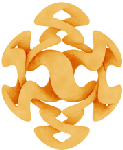
Tibetan
Buddhist Symbols
INTRODUCTION
Tibet is a vast country, spread out between India and the
Himalayas in the South, and China in the east. The traditional nomadic culture
was greatly influenced by the introduction of Buddhism from India, to an extent
that nearly all the cultural achievements of Tibet are related to the Buddhist
religion. Because of the predominance of tantra with its rich tradition of
symbolism, it is no surprise that symbols and symbolic artifacts of all sorts
are found in Tibet. Some of the symbols however originated in Tibet, or were
given a specific meaning within the local culture. Therefore, this page is
made separately from the other pages on symbolism of this website.
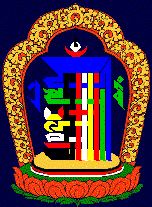 |
THE KALACHAKRA 'TENFOLD POWERFUL'
LOGO
This symbol can be found nearly everywhere where Tibetan
Buddhism is present, in various forms. It represents the teachings of
the Kalachakra tantra, one of the most complex tantric systems. This
symbol was developed in Tibet and is a schematic representation of letters
in the Lantsa script. The symbolism behind this logo is vast and has
explanations referring to the outer world, the human body at its gross
and subtle levels, and the practice of Kalachakra. A more extensive
explanation can be found on this
page of the International Kalachakra Network. |
PRAYER FLAGS, MANI WHEELS
AND MANI STONES
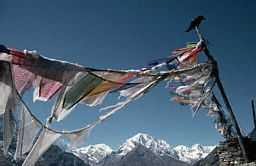 Typically
found in Tibetan areas are the many Prayer Flags that decorate monasteries,
houses and even mountain passes. It is believed that the special blessing
power of the mantras printed on them is spread all over the world by the wind.
The tradition stems from pre-Buddhist traditions in Tibet, just as the the
so-called Wind horse which is often found on them. Traditionally, prayer flags
have a combination of mantras, special prayers and auspicious symbols printed
on them. Typically
found in Tibetan areas are the many Prayer Flags that decorate monasteries,
houses and even mountain passes. It is believed that the special blessing
power of the mantras printed on them is spread all over the world by the wind.
The tradition stems from pre-Buddhist traditions in Tibet, just as the the
so-called Wind horse which is often found on them. Traditionally, prayer flags
have a combination of mantras, special prayers and auspicious symbols printed
on them.
Prayer flags are not only strung on ropes to hang between two poles, they
can also be hung like a flag from one pole.
Usually, the flags come in five different colors: blue corresponds with the
sky, white with clouds, red with fire, green with water and yellow with earth.
(This is different from the usual general symbolism of colors, which is related
to the elements: black/blue for air, red for fire, white for water and yellow
for earth.)
There are many different types of prayer flags, you can find some descriptions
at the Saraswati
Bhawan website.
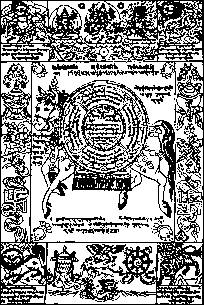 The
Wind Horse (Tib. Lung-ta), a mythical Tibetan creature from
pre-Buddhist times, combines the speed of the wind and the strength of the
horse to carry prayers from earth to the heavens. Not surprisingly in a country
where the horse was used by the traditional nomads of Tibet. It is associated
with success and the space element. The Wind Horse carrying the “Wish
Fulfilling Jewel of Enlightenment” is the most prevalent symbol used
on prayer flags. It represents good fortune; the uplifting life force energies
and opportunities that make things go well. When one’s lung-ta is low
obstacles constantly arise. When lung-ta is high good opportunities abound.
Raising Wind Horse prayer flags is one of the best ways to raise one’s
lung-ta energy. The
Wind Horse (Tib. Lung-ta), a mythical Tibetan creature from
pre-Buddhist times, combines the speed of the wind and the strength of the
horse to carry prayers from earth to the heavens. Not surprisingly in a country
where the horse was used by the traditional nomads of Tibet. It is associated
with success and the space element. The Wind Horse carrying the “Wish
Fulfilling Jewel of Enlightenment” is the most prevalent symbol used
on prayer flags. It represents good fortune; the uplifting life force energies
and opportunities that make things go well. When one’s lung-ta is low
obstacles constantly arise. When lung-ta is high good opportunities abound.
Raising Wind Horse prayer flags is one of the best ways to raise one’s
lung-ta energy.
"The traditional Wind Horse Prayer Flags are ancient
designs. In the center of the flag on the right, is the Wind Horse, the uplifting
energy that carries good fortune to all beings. In the corners are the "Four
Dignities": the Garuda (wisdom), the Dragon (gentle power) the Snow Lion
(fearless joy), and the Tiger (confidence). The Eight Auspicious Symbols (See
right) are depicted around the perimeter. Various prayers and mantras are
included in the text.
At the top center are the three main Bodhisattvas: Avalokiteshvara (Compassion),
Manjushri (Wisdom), and Vajrapani (Power). At the bottom center are the figures
called "the union of enemies" representing friendship. The two swastikas
are symbols of eternal life. There are many prayers for health, prosperity
and good fortune."
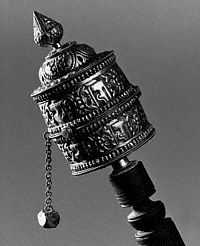 Prayer
Wheels are another typical Tibetan phenomena. They are usually crammed
with mantras, and similar to prayer flags, it is taught that the power of
the mantras will spread when the wheel is turned. The more mantras, the better.
Prayer wheels come in many variations; from handheld, like the one on the
left, to huge ones that require serious muscle power to set in motion. They
can be moved by hands, water or wind- with this cool
tool, even your hard disk can function as a prayer wheel. They are also
called Mani-wheels, as the wheels usually contain the mantra OM MANI
PADME HUM (the letters below show this famous mantra in Tibetan), which is
the mantra of Chenresig (Avalokiteshvara in Sanskrit). A thorough explanation
of prayer wheels can be found here,
and teachings of Lama Zopa Rinpoche on the
benefit of prayer wheels. Prayer
Wheels are another typical Tibetan phenomena. They are usually crammed
with mantras, and similar to prayer flags, it is taught that the power of
the mantras will spread when the wheel is turned. The more mantras, the better.
Prayer wheels come in many variations; from handheld, like the one on the
left, to huge ones that require serious muscle power to set in motion. They
can be moved by hands, water or wind- with this cool
tool, even your hard disk can function as a prayer wheel. They are also
called Mani-wheels, as the wheels usually contain the mantra OM MANI
PADME HUM (the letters below show this famous mantra in Tibetan), which is
the mantra of Chenresig (Avalokiteshvara in Sanskrit). A thorough explanation
of prayer wheels can be found here,
and teachings of Lama Zopa Rinpoche on the
benefit of prayer wheels.
The following story describes the origin of the prayer wheel
(from tantricheartwheels.com):
"Arya Chenrezig predicted to Master Ludrup Nyingpo,
"In the palace of the land of Naga is the Naga King Bodhisattva, who
is the owner of a profound wheel of Dharma. By hearing, seeing, touching
or thinking of this wheel, one can swiftly attain liberation from the suffering
of the three lower rebirths. If you go and fetch this wheel, the benefits
to sentient beings will be enormous."
Consequently, Master Ludrup visited the land of Naga and said to Naga King
Bodhisattva, "Oh, Naga King Bodhisattva, please pay attention to me.
I have come here because Arya Cherezig prophesized that the benefits to
sentient beings will be enormous if I beg from you your profound wheel of
Dharma, which can liberate beings from all types of sufferings of lower
rebirths just by hearing, seeing, touching or thinking of it. Kindly give
it to me."
Naga King Bodhisattva replied, "This wheel of Dharma, which has the
quality of quickly liberating all transmigrators from the great suffering
of the three lower rebirths merely by hearing, seeing, touching or thinking
of it, was kindly given to us in the past by the Buddha Mar Mezed, and has
given nagas much happiness. through it many have been led to the grounds
and paths of Buddhahood. This Dharma Wheel is the wheel of the mantra Om
Mani Padme Hung, the essence mantra Arya Chenrezig received from the Buddhas
upon request, and which represents the essence of all the qualities of body,
speech, mind and actions of the Buddhas. I shall give this wheel to you.
You must place it on or in earth, water, fire or wind and use it for the
sake of Dharma and living beings."
The wheel was passed on to Master Nagarjuna together with its instructions
for use. Master Nagarjuna brought it to India and later passed it on to
the Lion-Faced Dakini. From her the lineage passed through Tilopa, Naropa,
Marpa and Milarepa to Dakpo Lha Je, then to Khampa Yu Se and so on."
Another, very Tibetan, phenomena is to cut mantras into
stones, and pile them up to form entire walls. As the mantra carved onto
the stones is again often the Chenresig mantra "OM MANI PADME HUM",
they are also known as Mani-stones, often combined into Mani-walls.
KHATA OFFERING
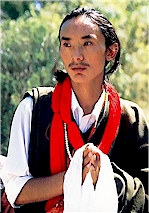 It
is customary to offer white scarves (Tibetan: khatag) at this time, or at
the very end, but this is not strictly necessary. If a khata is offered (held
as in the picture) then it should be placed in front of the lama or at his
side. Often, it will be returned to you (with the help of the assisting monk)
as a blessing, but not always. They may be available for purchase before the
ritual, but if you do not have one, you can offer a smile and a bow. It
is customary to offer white scarves (Tibetan: khatag) at this time, or at
the very end, but this is not strictly necessary. If a khata is offered (held
as in the picture) then it should be placed in front of the lama or at his
side. Often, it will be returned to you (with the help of the assisting monk)
as a blessing, but not always. They may be available for purchase before the
ritual, but if you do not have one, you can offer a smile and a bow.
There is often a natural inclination to make offerings to
the lama out of recognition for his or her kindness. Plan to bring an envelope
(or two, if you would like to donate something to the translator or other
assistant) into which you can put your contributions. It is customary to make
these donations at the end of the wang. You can place this on the lama's lectern
or desk with the katha.
Though the value of an empowerment cannot be measured in
dollars, that does not mean that money is unsuitable as an offering. Flowers
and fruit are suitable as offerings to Buddhas and Bodhisattvas; lamas who
are residents at dharma centres, who help build monasteries and schools, and
who travel widely need money. Each person should offer what he or she feels
is appropriate.
In Mongolia, the people often offer blue khatas.
See also the page of the
Tibetan Government on khatags.
THE FOUR DIGNITIES
The Four Dignities are mythical animals which represent various
aspects of the Bodhisattva attitude, like strength, protection and cheerfulness.
|
Dragon
The Dragon thunders in the sky with the sound of compassion that awakens
us from delusion and increases what we can know through hearing. Dragons
have the power of complete communication. Just as we do not see sound,
we do not see dragons -- at least not usually. Displaying a dragon
banner is said to protect one from slander and enhances one's reputation.
Associations: main quality is power, dominance over the sea, and the
water element.
|
|
Tiger
The Tiger abides in the South, symbolizing unconditional confidence,
disciplined awareness, kindness and modesty. It is relaxed yet energized;
resting in a gentle state of being that has a natural sense of satisfaction
and fulfillment, referring to the state of enlightenment.
Associations: main quality is confidence, dominance over forest, and
the air element.
|
|
Snow Lion
The Snow Lion resides in the East and represents unconditional cheerfulness,
a mind free of doubt, clear and precise. It has a beauty and dignity
resulting from a body and mind that are synchronized. The Snow Lion
has a youthful, vibrant energy of goodness and a natural sense of
delight. Sometimes the throne of a Buddha is depicted with eight Snowlions
on it, in this case, they represent the 8 main Bodhisattva-disciples
of Buddha Shakyamuni, the historical Buddha.
Associations: main quality is fearlessness, dominance over mountains,
and the earth element.
|
|
Garuda
The Garuda is daring and fearless and abides in the north. With great
strength and power it soars beyond without holding back. It symbolizes
freedom from hopes and fears, the vast mind without reference point.
It is a powerful antidote to the negative influences of Nagas (spirits)
which can cause disease and all kinds of harm.
Associations: main quality is wisdom, dominance over the sky, and
the fire element.
|
THE THREE SYMBOLS OF
VICTORY AGAINST DISHARMONY
These symbols can easily be confused when not looked
at carefully; for example, this Snowlion has a Garuda head....
Information and image from Andy
Weber's website.
The pairing of the six traditional enemies —
garuda and snowlion, otter and fish, crocodile (sea-monster) and seasnail
— creates the three mystical animals, symbols of universal love.
From Saraswati
Bhawan:
"The Union of Opposites (mithun gyulgyal) is an
interesting group of symbols. These mythological beings are joined rival
pairs of animals created to symbolize harmony. A snow lion and a garuda,
normally mortal enemies, were combined to form an animial with a snow
lion’s body and a garuda’s head and wings. Likewise a fish
was put together with an otter and a crocodile-like chu-srin was married
to a conch shell. These composed creatures are often put on Victory
Banners for the reconciliation of disharmony and disagreement."
|
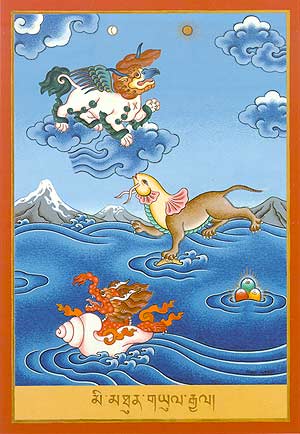 |
MOUNT KAILASH
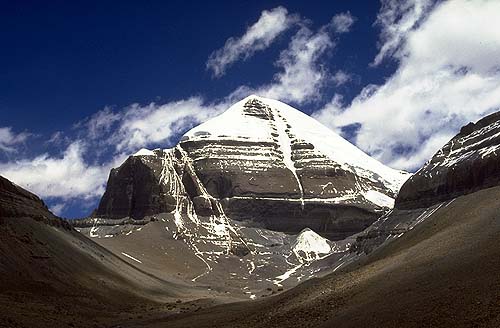 |
Mt. Kailash, Tibet |
Tibetans consider a pilgrimage journey around Mt. Kailash
very important, some people even manage this high-altitude, difficult trek
by making prostrations. It is even said that if one does 108 circumambulations,
one will reach enlightenment. Quite a number of tales are connected to the
mountain, linked with the greatest saints of Tibetan Buddhism, Guru Padmasambhava
and Milarepa, and is the abode
of the deity Chakrasamvara.
”There is no place more powerful for practice, more
blessed, or more marvelous than this; may all pilgrims and practitioners
be welcome!"
Milarepa
In Bon - Tibet's pre-Buddhist religion the mountain is called
Tise and is believed to be the seat of the Sky Goddess Sipaimen. (Hindus identify
it with the abode of Shiva. Jains call the mountain Astapada and believe it
to be the place where Rishaba, the first of the twenty-four Tirthankaras attained
liberation.)
See also this page from
Sacred Sites.
KARMAPA DREAM FLAG
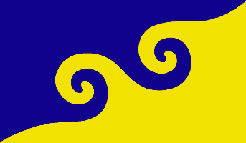 The
16th Gyalwa Karmapa, well known for his visions and prophesies, designed this
flag from a vision that came to him in a dream. He called it “Namkhyen
Gyaldar (Victorious Flag of Buddha’s Wisdom).” He proclaimed,
“Wherever this banner is flown the Dharma will flourish.” The
16th Gyalwa Karmapa, well known for his visions and prophesies, designed this
flag from a vision that came to him in a dream. He called it “Namkhyen
Gyaldar (Victorious Flag of Buddha’s Wisdom).” He proclaimed,
“Wherever this banner is flown the Dharma will flourish.”
According to the outer meaning the blue represents the sky
or heaven. The yellow symbolizes the earth. The wave symbolizes the Buddhadharma
penetrating heaven and earth.
According to the inner meaning the blue represents vision
and spiritual insight and the yellow symbolizes our experience of the everyday
world. The symmetry of the wave pattern shows the interdependence of the absolute
and relative levels of reality.
According to the secret meaning, the blue symbolizes emptiness-wisdom
and the yellow represents compassionate action. The wave is Mahamudra: the
union of compassion and wisdom- the ultimate realization of one’s true
nature.
MUSICAL INSTRUMENTS IN TIBETAN BUDDHISM
To make the offering of sounds, the Tibetans use a whole
range of musical instruments, from bells, cymbals, drums to wind instruments.
Especially some of the wind instruments may produce a very strange sound for
the Western ear, like the Long Horns which sound almost like a toneless blare
to the Thighbone Trumpets with a sometimes piercing sound. To judge for yourself,
do visit this page of the Nuns
of Khachoe Ghakyil, which include descriptions and even soundbytes of
the instruments.
TIBETAN THANKAS
A specific artform that has developed into perfection in
Tibet are the scroll-paintings or Thankas. On one hand the often nomadic people
liked to have images of deities and other subjects, but transportation of
conventional flat paintings was problematic. That is why the art of making
paintings that can withstand rolling up was developed into perfection. Traditionally,
very specific recipies are used for making the paint (mostly made of natural
minerals) and preparation of the canvas. You can find good information in
English and German on thankas and much of the symbolism involved on the site
of the Dharmapala Thanka Center.
BOOKS & LINKS ON TIBETAN BUDDHIST
SYMBOLISM
Tibetan Clipart
is a great source of vector-graphics which you can use to illustrate anything
and support an education project for Tibetan youngsters at the same time.
An excellent book on symbolism is Robert Beer's "Encyclopedia
of Tibetan Symbols and Motifs", Serindia publications.
A good classical one is Lama Anagarika Govinda's "Foundation
of Tibetan Mysticism", which describes a vast amount of symbolism
surrounding the mantra OM MANI PADME HUM.
See also the Khandro
website
Last updated: May 11, 2015 |

 Typically
found in Tibetan areas are the many Prayer Flags that decorate monasteries,
houses and even mountain passes. It is believed that the special blessing
power of the mantras printed on them is spread all over the world by the wind.
The tradition stems from pre-Buddhist traditions in Tibet, just as the the
so-called Wind horse which is often found on them. Traditionally, prayer flags
have a combination of mantras, special prayers and auspicious symbols printed
on them.
Typically
found in Tibetan areas are the many Prayer Flags that decorate monasteries,
houses and even mountain passes. It is believed that the special blessing
power of the mantras printed on them is spread all over the world by the wind.
The tradition stems from pre-Buddhist traditions in Tibet, just as the the
so-called Wind horse which is often found on them. Traditionally, prayer flags
have a combination of mantras, special prayers and auspicious symbols printed
on them. 
 Prayer
Wheels are another typical Tibetan phenomena. They are usually crammed
with mantras, and similar to prayer flags, it is taught that the power of
the mantras will spread when the wheel is turned. The more mantras, the better.
Prayer wheels come in many variations; from handheld, like the one on the
left, to huge ones that require serious muscle power to set in motion. They
can be moved by hands, water or wind- with this
Prayer
Wheels are another typical Tibetan phenomena. They are usually crammed
with mantras, and similar to prayer flags, it is taught that the power of
the mantras will spread when the wheel is turned. The more mantras, the better.
Prayer wheels come in many variations; from handheld, like the one on the
left, to huge ones that require serious muscle power to set in motion. They
can be moved by hands, water or wind- with this 

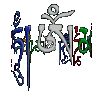
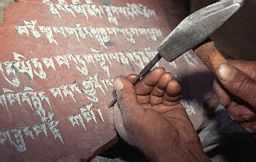
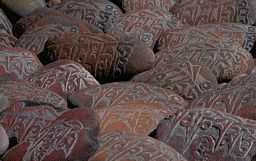



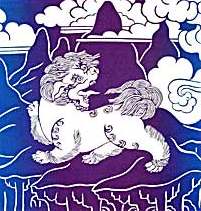



 The
16th Gyalwa Karmapa, well known for his visions and prophesies, designed this
flag from a vision that came to him in a dream. He called it “Namkhyen
Gyaldar (Victorious Flag of Buddha’s Wisdom).” He proclaimed,
“Wherever this banner is flown the Dharma will flourish.”
The
16th Gyalwa Karmapa, well known for his visions and prophesies, designed this
flag from a vision that came to him in a dream. He called it “Namkhyen
Gyaldar (Victorious Flag of Buddha’s Wisdom).” He proclaimed,
“Wherever this banner is flown the Dharma will flourish.”